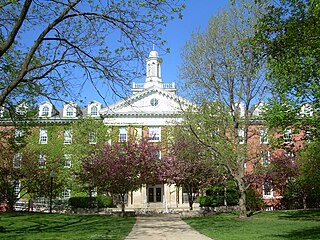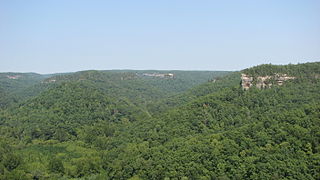Related Research Articles
The Alice Abel Arboretum is a 25 acres arboretum located at 5000 St. Paul Street on the campus of Nebraska Wesleyan University in Lincoln, Nebraska.

The Fell Arboretum is an arboretum located across the campus of Illinois State University in Normal, Illinois.

Peavy Arboretum is an arboretum operated by Oregon State University and located on Arboretum Road, Corvallis, Oregon. It is open to the public daily without charge.

The Appalachian mixed mesophytic forests is an ecoregion of the temperate broadleaf and mixed forests biome, as defined by the World Wildlife Fund. It consists of mesophytic plants west of the Appalachian Mountains in the Southeastern United States.

The Northern Anatolian conifer and deciduous forests is a temperate coniferous forests ecoregion located in northern Anatolia, Turkey.

The Appalachian–Blue Ridge forests are an ecoregion in the Temperate broadleaf and mixed forests Biome, in the Eastern United States. The ecoregion is located in the central and southern Appalachian Mountains, including the Ridge-and-Valley Appalachians and the Blue Ridge Mountains. It covers an area of about 61,500 square miles (159,000 km2) in: northeast Alabama and Georgia, northwest South Carolina, eastern Tennessee, western North Carolina, Virginia, Maryland, and central West Virginia and Pennsylvania; and small extensions into Kentucky, New Jersey, and New York.
The Museo e Arboreto Carlo Siemoni is a museum and historic arboretum located in Badia Prataglia, Poppi, Province of Arezzo, Tuscany, Italy.

Weeping trees are trees characterized by soft, limp twigs. This characterization may lead to a bent crown and pendulous branches that can cascade to the ground. While weepyness occurs in nature, most weeping trees are cultivars. Because of their shape, weeping trees are popular in landscaping; generally they need a lot of space and are solitary so that their effect is more pronounced. There are over a hundred different types of weeping trees. Some trees, such as the cherry, have a variety of weeping cultivars. There are currently around 550 weeping cultivars in 75 different genera, although many have now disappeared from cultivation.

The Apennine deciduous montane forests are a temperate broadleaf and mixed forests ecoregion in the Apennine Mountains of Italy. The development of these forests is ensured by the high rainfall in the Apennines, combined with a temperate-cool climate. Because of climate change, the presence of silver fir, although still widespread, has been dramatically reduced in favour of beech.

The Carpathian montane conifer forests, also known as Carpathian montane forests, is a temperate coniferous forests ecoregion in the Carpathian Mountains of the Czech Republic, Poland, Slovakia, Romania, and Ukraine.

The Iberian conifer forests is a Mediterranean forests, woodlands, and scrub ecoregion in southwestern Europe. It includes the mountain forests of southern and central Spain.
References
- ↑ Best Management Practices - Agroforestry Series Volume 1: Woodlot Management (18E ed.). Toronto, Ontario, Canada: Ontario Ministry of Agriculture, Food and Rural Affairs. 2007. p. 15.
- ↑ "Acer rubrum". www.fs.fed.us. Retrieved 2018-01-26.
- ↑ Hilje, Branko; Calvo-Alvarado, Julio; Jiménez-Rodríguez, César; Sánchez-Azofeifa, Arturo (23 March 2015). "Tree species composition, breeding systems, and pollination and dispersal syndromes in three forest successional stages in a tropical dry forest in Mesoamerica". Tropical Conservation Science. 8 (1): 76–94. doi: 10.1177/194008291500800109 . hdl: 2238/6926 . ISSN 1940-0829. OCLC 5807396390.
- 1 2 3 von Linstow, O. (1929). Bodenanzeigende Pflanzen (2. Aufl. ed.). Berlin: Preußisch Geologische Landesanstalt.
- ↑ Linden trees are sometimes regarded as shade-tolerant and sometimes as light-loving. Two German papers claim that light requirements of Tilia platyphyllos are greater than of Tilia cordata and that they change with climate, age of the tree and soil quality: Archived 2014-05-05 at the Wayback Machine Archived 2003-12-11 at the Wayback Machine